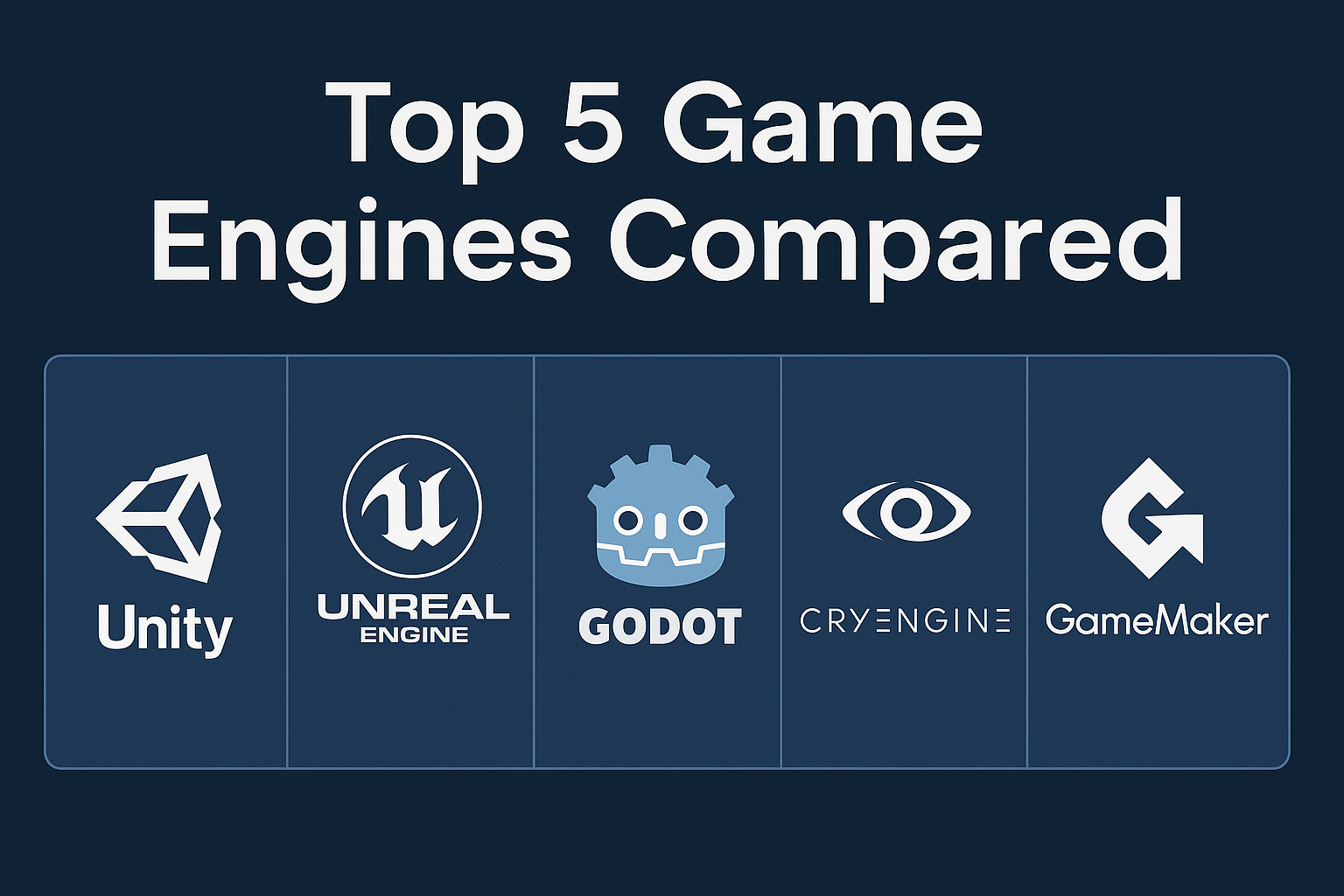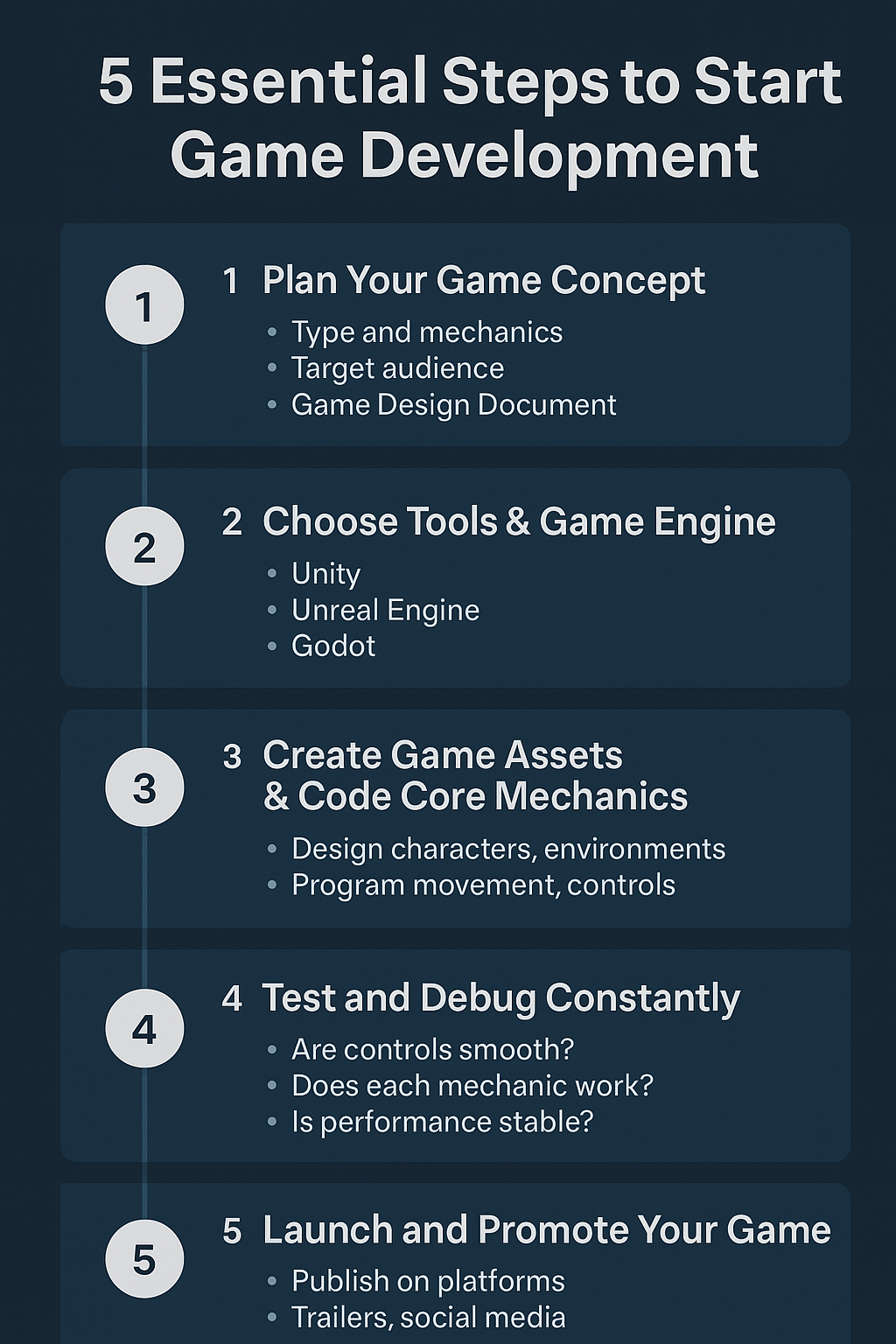
At Learn Rami, we specialize in crafting engaging and innovative Android games that capture players’ attention and deliver an exceptional gaming experience. Our team of skilled developers blends advanced technology with creative storytelling to transform your game ideas into reality. Whether you’re aiming for casual fun or competitive gameplay, Learn Rami is where powerful concepts meet seamless execution.
Top 5 Game Engines Compared: Unity, Unreal, Godot, and More
Game development is booming, and with so many powerful tools available, it’s easier than ever to build the game of your dreams. But with choices come decisions — especially when it comes to picking the right game engine. In this guide, we’ll walk through five top engines used by developers around the world, breaking down what makes each one unique.
1. Unity – The Indie Developer’s Favorite
Unity is one of the most widely used game engines today — and for good reason. It’s flexible, relatively easy to learn, and supports both 2D and 3D development.
Why developers love it:
Cross-platform support lets you publish games to mobile, PC, console, and even VR.
Tons of free and paid assets available on the Unity Asset Store.
Strong community support with countless tutorials and guides online.
Uses C#, which is easy to learn for beginners.
Things to consider:
Can become resource-heavy in large projects.
Some licensing restrictions for teams making over $100K/year.
2. Unreal Engine – Built for High-End Graphics
If your goal is to create visually stunning games, Unreal Engine should be on your radar. It’s the backbone behind many AAA games and delivers cinematic-quality graphics.
What sets Unreal apart:
The Blueprint system allows developers to create logic visually, with little to no coding.
Comes packed with tools for realistic lighting, physics, and animations.
Totally free to use until your game earns more than $1 million in revenue.
Downsides?
Steep learning curve for beginners.
Development projects require powerful hardware due to the engine’s size and complexity.
3. Godot – Open Source and Growing Fast
Godot is a gem in the world of free and open-source software. It’s gaining popularity among indie developers thanks to its lightweight setup and intuitive workflow.
Why it’s worth trying:
Completely free with no hidden fees or royalties.
Ideal for both 2D and small-to-mid scale 3D games.
Features GDScript, which is easy to understand even for non-coders.
What’s missing:
Smaller community compared to Unity and Unreal.
3D support is improving, but not as robust as the big engines yet.
4. CryEngine – Power and Realism
CryEngine is known for raw power and realistic environments. It’s great for developers who want to push hardware to its limits — especially in first-person shooters.
Highlights:
Impressive real-time rendering and detailed environments.
Offers full access to the source code for ultimate control.
No royalties required — pay what you want model.
Challenges:
Less beginner-friendly.
Smaller support base and community compared to other engines.
5. GameMaker Studio – Quick & Easy for 2D Games
GameMaker Studio is built for simplicity. If you’re new to game development or focusing on 2D games, this could be the best place to start.
Why beginners love it:
Drag-and-drop interface with optional scripting using GML.
Great for prototyping and publishing quickly.
Well-documented and beginner-friendly.
But:
Lacks powerful 3D support.
Some export features require paid licenses.

Is Unreal Engine Worth Learning in 2025?
With gaming technology advancing rapidly, many developers ask: Is learning Unreal Engine still worth it in 2025? The answer is a strong yes — especially if you’re aiming for top-tier visuals and professional projects.
Unreal Engine stands out with its stunning graphics, real-time lighting, and cinematic effects. It’s widely used in AAA games, virtual production, and even architecture. The Blueprint system also makes it easier to create complex logic without needing to write code from scratch.
Although it has a steeper learning curve than engines like Unity or Godot, the results speak for themselves. If you’re serious about game development or want to break into the professional scene, Unreal is one of the best skills you can learn today.


The Rise of Progressive Web Apps
Progressive Web Apps (PWAs) have been gaining momentum over the past few years, and by 2025, they are expected to become a standard for modern web development. PWAs combine the best elements of web and mobile apps. They are responsive, fast, reliable, and capable of working offline—offering users an app-like experience without requiring them to download anything.
Thanks to service workers, caching strategies, and browser support improvements, PWAs are becoming more capable and accessible. Brands like Twitter, Pinterest, and Starbucks have already seen huge engagement boosts by switching to PWAs, and this trend is only growing.
Why it matters in 2025:
With more users expecting seamless and responsive digital experiences across all devices, PWAs offer a cost-effective, scalable solution that improves performance and user retention.
- AI-Powered Websites: Artificial intelligence is being used to enhance website personalization and optimize user experience. From chatbots to predictive search, AI can help make websites smarter and more user-friendly. without needing to download anything.
Artificial Intelligence and Automation Take Center Stage
Artificial Intelligence (AI) is no longer a buzzword—it’s a foundational technology shaping the future of the web. From personalized content recommendations to predictive search and intelligent chatbots, AI is helping websites become more dynamic and user-focused.
AI is also transforming how websites are built. No-code and low-code platforms are using AI to generate code, design templates, and even test usability. This significantly reduces development time and empowers non-developers to build functional sites.
Examples of AI in web development:
Smart content generation (e.g., product descriptions, blog posts)
AI chatbots providing 24/7 customer support
Behavior tracking and automated UX optimization
Voice-activated navigation and commands
Why it matters in 2025:
AI tools will be deeply embedded into most development workflows, not just as features but as collaborators. This trend will democratize development and increase productivity.

Responsive and Adaptive Design Evolve
Mobile-first design is already the norm, but 2025 is taking things a step further. With the proliferation of devices—foldable phones, smartwatches, AR headsets, and more—web developers must create layouts that go beyond simple responsiveness.
Adaptive design uses data such as screen size, browser type, and user behavior to deliver optimized experiences for each device. For instance, a smartwatch-friendly version of a site might highlight notifications and voice commands, while a foldable phone layout may adjust seamlessly as the screen size changes.
Why it matters in 2025:
Websites need to work not just on mobile devices, but for them, tailoring interfaces and functionality for emerging tech like wearables, in-car displays, and IoT-connected devices.

Game Developer: A Complete Guide
The mobile gaming industry has seen explosive growth in recent years, and Android game development lies at its core. With billions of Android users worldwide, creating games for this platform presents a lucrative and exciting opportunity. Whether you’re a beginner or an experienced developer, mastering the fundamentals of Android game development can set you on a path to building captivating and successful mobile games.
Who Is an Android Game Developer?
An Android game developer is a programmer who designs, develops, and maintains mobile games specifically for Android devices. These developers use programming languages like Java, Kotlin, and C#, along with popular game engines such as Unity, Unreal Engine, and Godot, to create rich, interactive experiences for players.
5 Essential Steps to Start Game Development in 2025
Game development has grown from a niche skill to a thriving global industry. Whether you’re an aspiring solo creator or planning a full indie studio, the process of building a game can feel overwhelming — but it doesn’t have to be. Here’s a simple breakdown of the 5 key steps every game developer should follow in 2025.
1. Plan Your Game Concept
Before writing any code or creating graphics, start with your idea.
What type of game are you making? (2D, 3D, RPG, FPS, platformer, etc.)
Who is your target audience?
What are the core mechanics — jumping, shooting, puzzle-solving?
Pro Tip: Write everything in a Game Design Document (GDD). This helps keep your vision clear and organized as you move forward.
2. Choose the Right Tools and Game Engine
Your choice of tools can make development smoother.
Popular game engines in 2025 include:
Unity – Great for 2D/3D and mobile games
Unreal Engine – Ideal for high-quality graphics and AAA-style games
Godot – Lightweight, free, and open-source
You’ll also need tools for artwork (like Blender or Photoshop) and sound (like Audacity or FMOD).
3. Create Game Assets and Code Core Mechanics
Now the real building starts.
Design characters, animations, environments, UI, and more. At the same time, begin programming your game’s logic — movement, physics, controls, menus, etc.
This step may involve:
Writing scripts (C#, C++, GDScript, etc.)
Importing textures, models, and audio
Setting up levels and scenes
4. Test and Debug Constantly
No game is perfect on the first try.
You’ll need to test each part:
Are the controls smooth?
Is the performance stable on all devices?
Do enemies and mechanics work as expected?
Debugging takes time but is crucial for quality.
5. Launch and Promote Your Game
Once your game is polished, it’s time to release it!
Depending on your audience, you can publish on platforms like:
Steam
Google Play
Apple App Store
itch.io
Don’t forget to promote your game through trailers, social media, game dev forums, and influencers.

Final Thoughts
Game development is a creative and technical journey. With the right tools, a clear plan, and a willingness to learn, anyone can bring their game ideas to life. Stick to these five steps, stay consistent, and enjoy the process of building your own world.
Are you ready to creat you first android game and enter the booming world of mobile gaming